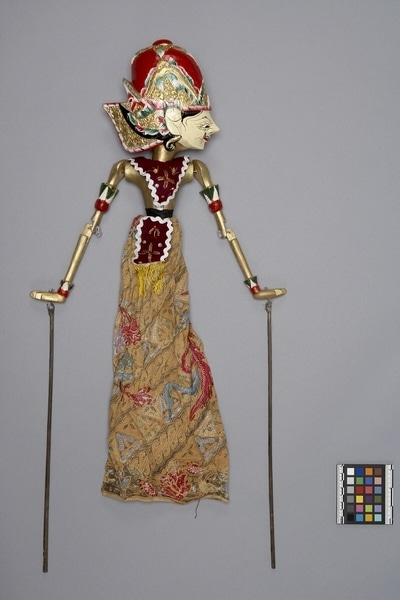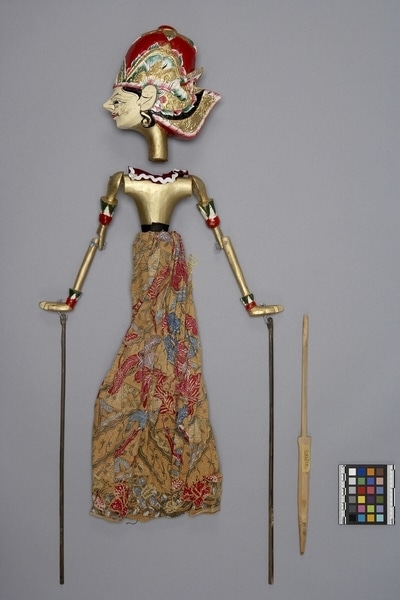Rod Puppet Item Number: Ib408 a-c from the MOA: University of British Columbia


Description
Three-dimensional male humanoid figure; large head and jointed arms attached to controlling rods. Light cream face with slightly curved, pointed nose, white eyes with black pupils cast downwards. Red lips; moustache, beard, hair, other facial details in black. Large red crown (mahkota) headdress with gold, green, and black components, notably a large badong, red Garuda with black tail, and single black hair curl with gold stripe. Neck, upper torso gold: arms with green, white, and red ornaments at bicep and wrist. Hands held flat and bent back at wrist. Purple chest covering and long apron with white wavy trim and sequins and twisted wire decoration. Apron has black waistband, and yellow frills at bottom. Long batik skirt (orange, red, blue, and lavender).
History Of Use
Javanese puppetry as an art form probably developed by the 11th century. Wayang golek puppets of western Java appeared during the 16th century. Originally the plays depicted Javanese mythology, but after the Indian conquest of Java the Hindu epics, Ramayana and Mahabharata, were incorporated into the cycles, which comprise about 200 plays. A dalang (puppet master) performs the plays to celebrate important occasions, usually in three acts, with vocal and instrumental accompaniment. Typically they serve a moral and religious purpose, and more recently, one of political commentary. Shiva appears in all play cycles; he is the king of the Hindu pantheon and father of Brahma, Indra, and Vishnu, among others.
Cultural Context
Theatrical performance.
Iconographic Meaning
Each puppet is characterized by its wanda, a Javanese word which describes the specific mixture of elements of size, form, colour, ornamentation and carving. Position of face and eyes denote virtue, spirituality; delicate facial features, position of hands, batik, and particularly headdress indicate refinement and nobility of a high degree (king or god). Headdress and face identify puppet as Shiva, overlord of the Hindu pantheon.
Item History
- Made in Java, Indonesia
- Owned by Donald Bone before January 4, 1980
- Received from Donald Bone (Seller) and Museum of Anthropology Donations Fund (Funding source) on January 4, 1980
What
- Name
- Rod Puppet
- Identification Number
- Ib408 a-c
- Type of Item
- puppet
- Material
- fibre, paint, wood and cotton fibre
- Manufacturing Technique
- carved, painted, tied, woven and sewn
- Part A
- height 61.0 cm, width 17.0 cm, depth 7.0 cm
- Part B
- height 19.0 cm, width 18.0 cm, depth 7.6 cm
- Part C
- height 33.0 cm, width 2.0 cm, depth 1.0 cm
Who
- Culture
- Sundanese
- Previous Owner
- Donald Bone
- Received from
- Donald Bone (Seller) and Museum of Anthropology Donations Fund (Funding source)
Where
- Holding Institution
- MOA: University of British Columbia
- Made in
- Java, Indonesia
When
- Ownership Date
- before January 4, 1980
- Acquisition Date
- on January 4, 1980
Other
- Condition
- good
- Accession Number
- 0586/0028 a-c